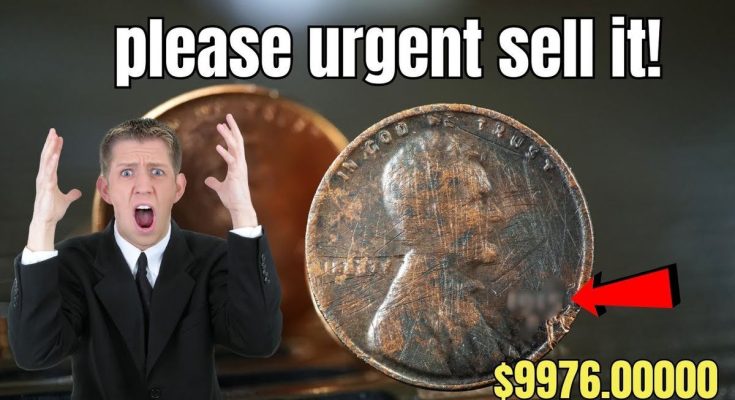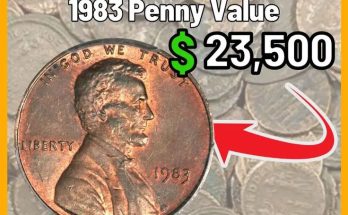🌟 TOP 16 ULTRA RARE PENNY COINS WORTH A LOT OF MONEY! 💰
The Unbelievable Rarity of the Humble Cent
The penny is the most common coin in American pockets, yet it holds the greatest potential for life-changing discovery. The search for ultra-rare penny coins is a thrilling treasure hunt rooted in historical context, industrial error, and a few key low-mintage years. These aren’t just old coins; they are anomalies—mistakes that slipped past the U.S. Mint’s quality checks to become legends.
If you are serious about finding an expensive coin, you must train your eye for the following Top 16 ultra-rare pennies. The differences are often subtle, but the rewards are massive, with values soaring into the hundreds of thousands and even millions of dollars.
The Million-Dollar “Key Dates” & “Composition Errors” (The Holy Grails)
The most valuable pennies are generally those struck on the wrong metal planchet during WWII or those with the lowest mintages from the early 20th century.
-
1943-D Bronze (Copper) Cent: (Denver Mint) The single rarest Lincoln Cent. It was accidentally struck on a bronze planchet instead of the zinc-coated steel used in 1943 due to wartime copper rationing. The only known example sold for $1.7 million.
-
1943-S Bronze (Copper) Cent: (San Francisco Mint) The bronze version from San Francisco. Only a handful are known to exist.
-
1943 (P) Bronze (Copper) Cent: (Philadelphia Mint) The plain 1943 bronze cent, another wartime error.
-
1944-D Steel Cent: (Denver Mint) The reverse error—struck on a leftover steel planchet in a year where copper was restored. Extremely rare.
-
1909-S VDB (Wheat Cent): The king of key dates. It has the designer’s initials (VDB) on the reverse and a low mintage (484,000) from the San Francisco Mint. High-grade coins have sold for over $1.2 million.
-
1914-D (Wheat Cent): An extremely low-mintage business strike (1.193 million). Known for being notoriously difficult to find in high grades.
Doubled Die Errors (The Biggest Mistakes)
These coins were created when the die was mistakenly struck twice, causing doubling on the features. The most dramatic errors command the highest prices.
-
1969-S Doubled Die Obverse (DDO): (San Francisco Mint) This is one of the rarest Doubled Die errors, with distinct doubling on “LIBERTY” and the date “1969”. Must not have a doubled “S” mint mark. Record auction prices reach $126,500.
-
1955 Doubled Die Obverse (DDO): (Philadelphia Mint) The most famous error. The doubling on the date and lettering is clearly visible, even without magnification.
-
1958 Doubled Die Obverse (DDO): (Philadelphia Mint) Only three examples of this dramatic error are known. One sold for $336,000, making it one of the most valuable errors ever found.
-
1972 Doubled Die Obverse (DDO): (Philadelphia Mint) Easily visible doubling on the date, “LIBERTY,” and the motto. Very popular with collectors.
-
1971 Doubled Die Obverse (DDO): (Philadelphia Mint) While less dramatic than the ’55 or ’72, a strong example of the doubling on the obverse can command thousands of dollars, making it a valuable find.
Modern & Transition Errors (The Current Hunt)
Even modern pennies, minted after the composition switch to zinc, have costly errors:
-
1999 Wide AM (Memorial Cent): (Philadelphia Mint) The “A” and “M” in “AMERICA” on the reverse are separated, resembling the spacing used on the proof coins. The rarest examples have sold for over $138,000.
-
1992 Close AM (Memorial Cent): (Philadelphia Mint) The “A” and “M” in “AMERICA” are touching or very close, which was not standard for business strikes that year. Worth thousands in high grade.
-
1982-D Small Date Copper Cent: (Denver Mint) In 1982, the U.S. Mint transitioned from copper (3.1g) to zinc (2.5g). It is widely believed that a small number of the rarer “Small Date” coins were mistakenly struck on the heavy copper planchets at the Denver Mint. The value is contingent on weighing precisely 3.1 grams. Only one is widely confirmed, making it a multi-thousand dollar coin.
-
1983 Doubled Die Reverse (DDR): (Philadelphia Mint) The doubling is visible on the reverse, particularly on “UNITED STATES OF AMERICA” and the columns of the memorial.
-
1922 “No D” (Plain Cent): (Denver Mint) A low-mintage key date where the Denver “D” mint mark was accidentally polished away from a heavily abraded die. The entire coin often looks weak, but the absence of the “D” is the key.
The excitement of numismatics is that many of these treasures are still waiting to be found. Keep your eye sharp, your magnifying glass ready, and always check the dates, mint marks, and composition—the next Ultra Rare Penny could be yours!



